“The need for more adequate transportation in Tokyo has been very evident for several years. Tokyo’s tram system is totally incapable of standing up to the demands made upon it and, in addition, the population of the city, including suburbs, is yearly increasing by some 133,000.
“The first line of projected subway is to extend over 9-1/2 miles, and is to connect with the high-speed electric railway system operated between Tokyo and Yokohama by the Government Department of Railways. Whatever subway may be built in the more distant future, it is believed that no other line can fully develop its functions unless connections are secured with the first and centrally located line, which may be said to form an artery of traffic facilities through the very heart of the business district.
“As the promoters see the project, building of this first underground railway will be the antecedent to the building of a ‘Greater Tokyo,’ an enterprise symbolizing true progress and a good investment in the most advanced economic sense.
“When these programs have been completed, Tokyo will have almost the equal of half the mileage of underground railways in Paris.”
– The Trans-Pacific, August 1922
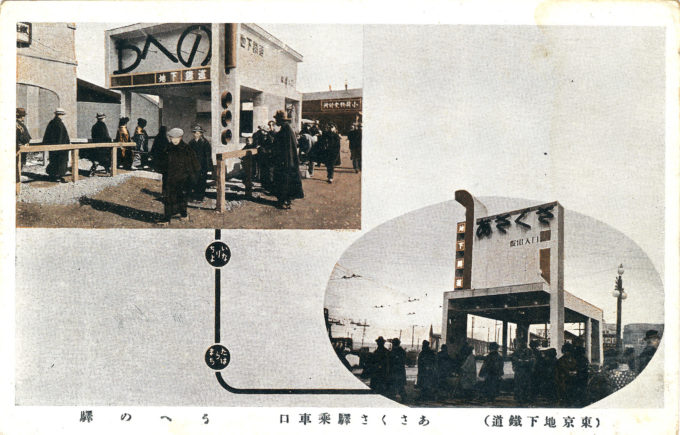
Terminal entrances at Ueno (upper left) and Asakusa (lower right) on the opening day of the Tokyo Underground Railway Co., Tokyo, December 30, 1927, with Inaricho and Tawaramachi stations labeled between them.
“The electric tram service operated by the Municipal Electric Bureau is woefully insufficient to carry the vast army of workers daily commuting between the business centers and the suburban districts. Car after car is filled with passengers to overflowing. Every car-stop is a scene of confusion. Crowds struggle to climb aboard the trams at busy corners. Squeezed and squashed and pushed hither and thither, the aged, the women and the children find it very hard to get about by tram.
“… The city of Paris, covering an area about the same as that of Tokyo and having a population which may fairly be compared with that of this city is provided with 59 miles of high-speed traffic facilities, most of which are subways. If to this be added a subway under construction and a projected underground railway extending, together, over 28 miles, the total of the Paris high speed traffic will be 87 miles. Compared with this, Tokyo’s 2.4 miles of elevated railway [between Tokyo Central and Shimbashi stations] dwindles almost into insignificance. In tramway service, Tokyo is, also, behind Paris, for while the former has 180 miles of track inclusive of the suburban line, Paris boasts 1,020 miles of such inclusive of suburban lines.
Map: Proposed Tokyo city mass transit improvements, 1922. The proposed route for the first subway — Minamisenju-Shinagawa via Asakusa, Ueno, Nihonbashi and Shimbashi — is highlighted in red. The first section, between Ueno and Asakusa, was completed in 1927 but wouldn’t reach Shimbashi until 1934. Highlighted in purple are proposed high-speed elevated railways (that were never built) coming into the center of the city from three suburban hubs — Shibuya, Shinjuku, and Otuska — with a transfer point to the subway at Manseibashi Station. Phase II proposed subway lines (Ikebukuro-Suzaki, Sugamo-Manseibashi, and Asakusa-Meguro) are marked by solid-hashed lines. [Source: The Trans-Pacific, August 1922]
“… Japan has of late years developed greatly in various directions. Large stores and office buildings are making their appearance one after another in such thoroughfares as Marunouchi, Ginza and Nihombashi, and it is no longer rare to see women employed in these, indicating an increasing traffic problem as the female population gradually becomes accustomed to seek work outside of the home.
“That present facilities are insufficient to meet the increasing requirements of the people needs no elucidation. This very obvious need of more adequate traffic-carrying facilities has caused the launching of the Tokyo underground railway project.”
– The Trans-Pacific, August 1922
Rolling Stock
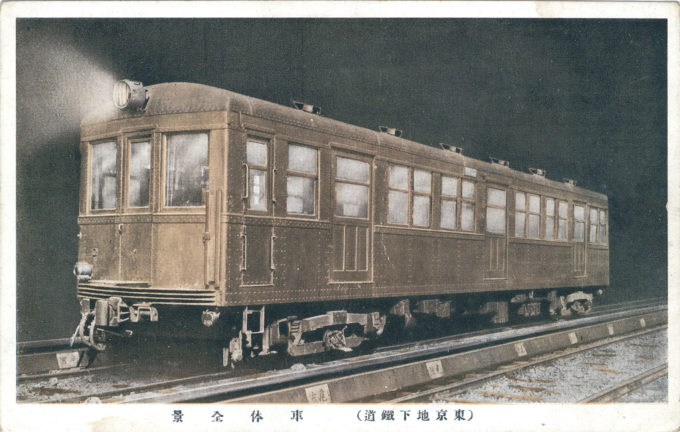
Exterior, Type 1000 subway carriage, Tōkyō Chika Tetsudō (aka “Ginza Line”), Tokyo, c. 1927, in service for over forty years, until April 1968. But as the carriages aged they were slowly replaced by 1500N and 2000 series sets starting in 1959. The cars were lemon-yellow colored and emblazoned with the Tokyo Underground Railway Co.’s stylized T and C logo. To prevent collisions, the rail beds were equipped with the “trip cock” Automatic Train Stop System, an electro-pneumatic device that halted a train if it tried to run a red signal and so successful it remained in use on the Ginza Line until 1993 and the Marunouchi Line until 1998.
- Subway carriage interior, Tōkyō Chika Tetsudō (aka “Ginza Line”), Tokyo, c. 1927. The Type 1000 was the first carriages employed for service by the Tokyo Underground System.
- The switchback for subways at Asakusa Station, Tokyo, 1927.
“The Ginza Line was conceived by a businessman named Noritsugu Hayakawa, who visited London in 1914, saw the London Underground and concluded that Tokyo needed its own underground railway. He founded the Tokyo Underground Railway (Tōkyō Chika Tetsudō) in 1920, and began construction in 1925.
“The portion between Ueno and Asakusa was completed on December 30, 1927 and publicized as ‘the first underground railway in the Orient’. Upon its opening, the line was so popular that passengers often had to wait more than two hours to ride a train for a five-minute trip.
“On January 1, 1930, the subway was extended by 1.7 km to a temporary station at Manseibashi which was abandoned in November, 1931 when the subway reached Kanda, 500 meters further south down the line. The Great Depression slowed down construction, but the line finally reached its originally planned terminus of Shinbashi on June 21, 1934.
“In 1938, the Tōkyō Rapid Railway (Tōkyō Kōsoku Tetsudō), another private concern tied to the predecessor of today’s Tokyu Corporation, Toyoko K.K., began a subway service between Shibuya and Toranomon. It was later extended to Shinbashi in 1939, at which time the two lines began through-service interoperation. The two were formally merged into the Teito Rapid Transit Authority (‘Eidan Subway’ or ‘TRTA’) in July 1941.
“The ‘Ginza Line’ name was formally applied in 1953 to distinguish the line from the then-new Marunouchi Line.
“According to a June 2009 Tokyo Metropolitan Bureau of Transportation survey, the Ginza Line is the seventh most crowded subway line in Tokyo, running at 168% capacity between Akasaka-Mitsuke and Tameike-Sannō stations.”
– Wikipedia
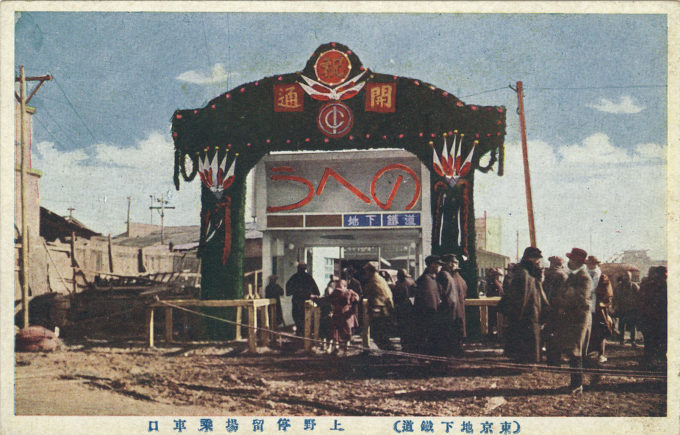
Ground level entrance on opening day outside the government railway’s Ueno Station. Tokyo Chikatetsu Ueno Station, December 1927.
Station Interiors
- Platform, Chikatetsu Ueno Station, Tokyo, 1927.
- Platform, Chikatetsu Tawaramachi Station, Tokyo, 1927.
- Platform, Chikatetsu Inaricho Station, Tokkyo, 1927.
- Asakusa Station, Tokyo, 1927.


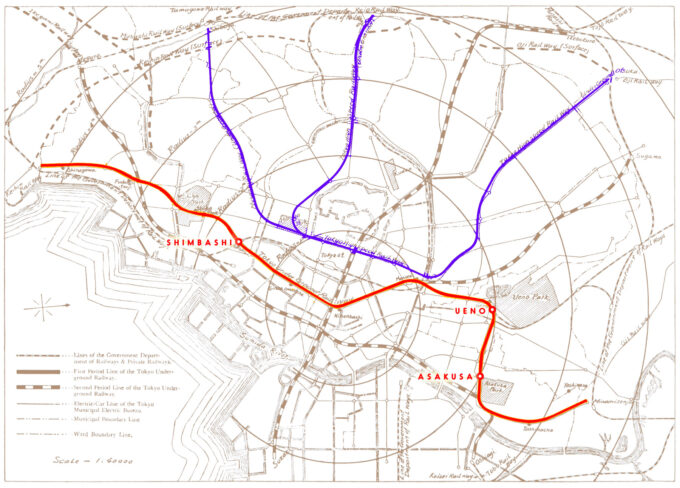


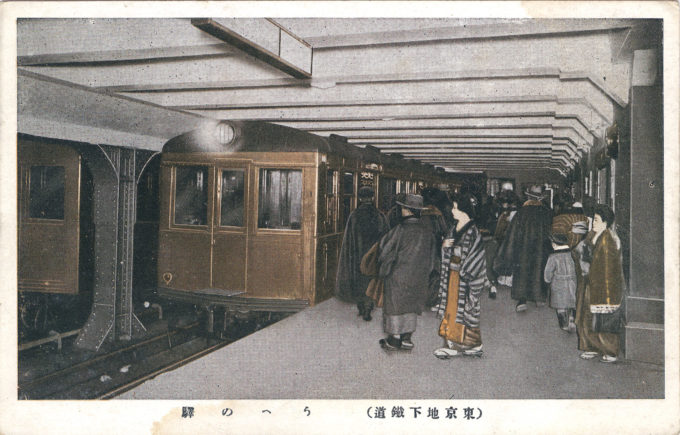
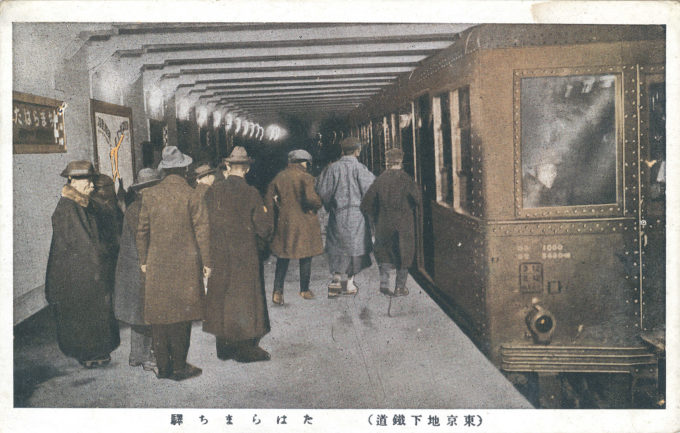

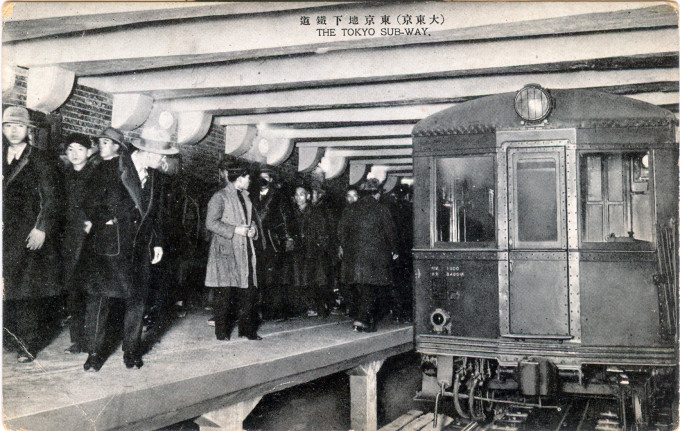
Pingback: Whewell’s Gazette: Year 3, Vol. #20 | Whewell's Ghost
Pingback: Opening of the Chikatetsu (Tokyo Underground Railway Co.), December 1927. | Old Tokyo
Pingback: Opening Day of the “Chikatetsu”, Tokyo Underground Railway Co., December 1927. | Old Tokyo